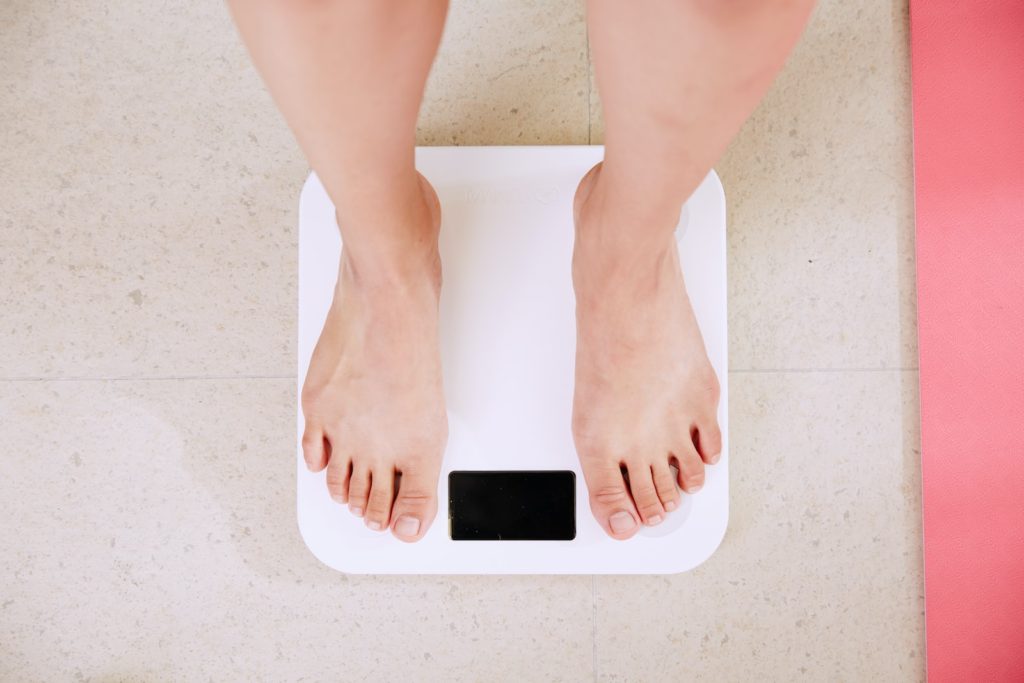The answer may shock you
Keto is one of the most popular diets out there, period.
But, how much weight can you realistically expect to lose with keto in your first month?
In this article, we’ll discuss how much weight the average person could lose on keto, & how much weight you could lose on keto if you were really pushing it.
How Does Keto Work?
The keto diet works by eliminating carbs, thus making your body rely on fat for fuel. Once your body can only use fat as energy, it can start to turn its own fats into ketones, which will serve as your energy & fat-loss method on keto.
A ketogenic diet has been shown to help you lose weight quickly. In fact, a low-carb diet is said to help you lose weight faster than any other diet.
However, ‘experts’ claim that water retention is the reason for this.
Is that true? It may be, but:
Who wants to have water retention in their abdomen or other areas where it isn’t desired?
Nobody.
Not only does keto quickly get rid of the excess water in your body, but it also can help you to lose a lot of weight, very fast.
How Much Weight Can You Lose In a Month on Keto?
You can lose around 12 – 18 pounds (~5.5 kg to ~8 kg) for your first month on keto. However, around 10 pounds of that weight loss will be water weight you lose from the first week.
Yes, you can definitely lose 12 to 18 pounds your first month on keto (or for the British readers, a stone.)
If you started out with a lot of weight to lose, you may lose more weight than the average, something like 18 pounds in the first month. That’s because bigger people have to carry & move with more fat, so they burn a little more calories just by existing.
However, if you’re a smaller person, you can expect to lose around 12 pounds during your first month on keto.
What if I Need to Lose a Lot of Weight?
If you need to lose a lot of weight quickly on keto, you can achieve around 40 pounds of weight loss in your first month. However, that number is only achievable if you implement other things on top of keto, like OMAD fasting, prolonged dry fasting, or further calorie restriction.
It’s all right to go keto if you need to lose a lot of weight. In fact, keto is the best diet for overweight people. Why?
Keto is great for bigger people because keto is meant to use your own fat for fuel. Even if you have more fat on your body, it’ll just be used for fuel & you won’t have to go through the suffering that normal diets induce.
What Can I Eat on Keto?
When you follow the ketogenic diet, you eat foods that are low in carbohydrates, & high in fats. Foods like fatty meats, seafood, full-fat dairy, nuts, avocados, & low-carb vegetables are all great on keto.
The keto diet causes your body to use its fat reserves as fuel through ketosis.
Have you ever felt a slightly dizzy, slightly euphoric, or heady feeling after eating?
That is your glycemic index shooting through the roof.
The goal of keto is to eat low-carb foods so you can lower insulin, the fat-storing hormone, lower calories, & induce ketosis so you can use your own fats as fuel.
Beat the Keto Flu
Getting into ketosis might be difficult if you have been eating carbs for a long time, like most people. That’s why it’s important to beat the keto flu early on so you can stick to keto.
Basically, the keto flu starts the first week or two when you begin keto. When people first start keto, they may experience symptoms similar to the flu, like fatigue, muscle soreness, & brain fog.
The reason the keto flu happens is that your body’s electrolytes become diminished on keto.
That’s because carbs hold a lot of water. So when you eliminate carbs, the water goes with it.
However, when your body expels all that water, the electrolytes go with it. That means that you’ll get symptoms of electrolyte imbalance with the keto flu. However, you shouldn’t worry.
The Solution to the Keto Flu
The solution to the keto flu is to take 1/2 teaspoon of sea salt daily with water, or on your food, & to eat more vegetables. These two things will help replace the sodium, electrolytes, minerals, & water in your system so you can beat the keto flu.
Slow & Steady Wins the Race on Keto
We get it, everyone wishes to drop weight fast. However, losing too much weight too rapidly isn’t healthy, and your brain can’t keep up either, no matter what diet or way of eating you follow. Moreover, people who shed weight too rapidly often desire to eat more, thus regaining some of it.
Keto = No More Water Weight
According to research, every gram of carbohydrate your body holds is associated with about three to four grams of water, which translates to a boatload of water weight for carb eaters.
Water weight contributes to a number of problems, including bloating and aching joints.
On keto, you’ll lose most of the water weight in the first week.
How Much Water Weight Will I Lose on Keto?
On the first week of being on keto, you can expect to lose around 10 pounds, but most of it would be water weight, not fat.
People who say that ‘it’s just water weight’ are correct, but it’s still great to see it go on keto.
Will Weight Come Back if I Stop Keto?
If you stop doing keto, you’ll slowly gain the weight back, but not as fast as other diets. That’s because keto destroys the fat cells instead of shrinking them, making it more difficult to create new fat cells.
However, you will notice that water weight accumulates very quickly once you start eating carbohydrates again due to their inflammatory & water-storing nature.
It’s up to you whether you’d like to eat keto until you get to your desired weight & then quit. However, if you do go back to eating a lot of sugars & simple carbs, you’ll gain the weight back, forcing you to go back onto keto.
Long-Term Weight Loss is Better With Keto
The thing most people prefer about keto more than anything else is that research has shown that on keto or low-carb diets, our fat cells decrease more than with any other eating method. As a result, weight reduction is more difficult to reverse.
However, that doesn’t mean you can have all the baguettes you want.
I’ve Been on Keto for a Month, Now What?
After the first month of being on keto, the rate at which you lose weight will slow down to around 2 pounds a week because you have lost all of your water weight. Just continue doing keto & consider doing intermittent fasting in addition to keto to speed up weight loss.
You have lost weight, great!
It doesn’t matter if you’re strictly keto or just low-carb, as long as the diet is sustainable, that’s what matters.
However, if you want to lose weight faster, I recommend starting intermittent fasting for the enhanced benefits of keto.
If you want to learn more about intermittent fasting, here’s my article detailing how to start OMAD fasting & why you should.
What if I Stop Losing Weight on Keto?
If you stop losing weight on keto, try adding fasting on top of keto. For example, you can get started with intermittent fasting, a type of eating plan where you eat 8 hours of the day & don’t eat anything the other 16 hours of the day.
When I stopped losing weight on keto, I was only around halfway done with my weight loss goal.
However, I kept learning & experimenting with other forms of weight loss, & stumbled across fasting with keto.
Intermittent Fasting
Intermittent fasting is a type of fasting where you only eat in an 8-hour period of the day & fast the other portion of the day.
Many people on keto already do types of fasting, like intermittent fasting.
I did intermittent fasting + keto until I got to 70% of my weight loss goal.
OMAD (One Meal a Day) Fasting
OMAD (one meal a day) fasting is, as the name implies, a type of intermittent fasting where you only eat one meal a day. With OMAD, I actually felt more satiated & energetic than when I was doing intermittent fasting, likely because I could utilize my fat better.
OMAD is basically the same as intermittent fasting, but it just lowers insulin & calories (unconsciously) a little more.
I started doing OMAD (one meal a day) + keto, & then I got to around 85% of my weight loss goal.
I thought that keto + OMAD was as far as I could go, however, I hadn’t tried prolonged fasting.
Prolonged Fasting
In prolonged fasting, you don’t eat for a couple of days with the goal of reducing insulin & calories whilst burning fat through ketosis.
I did OMAD daily, & then around once a week I would do a prolonged wet fast, which was a mistake.
Prolonged Wet Fasting vs Prolonged Dry Fasting
Prolonged wet fasting is a type of fast where you can drink water during the fasting period. Prolonged dry fasting is a type of fasting where you don’t eat or drink water. Prolonged dry fasting is more effective than wet fasting because it burns fat with 2x the intensity.
Wet fasting is good for intermittent fasting since water is good for your body. However, dry fasting is much better for prolonged fasts because it’s 2x more effective for the same duration.
Also, on a dry fast, you don’t have to worry about supplementing with electrolytes. On a wet fast, however, you need to use electrolytes or as your body urinates, & as you don’t eat, you’ll just keep flushing out electrolytes.
With a prolonged dry fast, you can lose around 3 pounds per day, with around 1 pound of it being fat.
Science is unable to fully comprehend the human body, so we don’t fully understand why weight plateaus. However, it is normal for weight loss to plateau. To break the plateau, fast.
Conclusion
In conclusion, you can lose around 12 – 18 pounds in your first month of being on keto.
However, if you eventually stop losing weight, or if want to lose weight faster, try fasting.
The most beginner-friendly type of fasting is intermittent fasting.
Then, later on, you can progress to OMAD fasting & prolonged dry fasting.
If you’re interested in starting OMAD fasting, here’s my article detailing the benefits of OMAD & how to start.
- Can You Still Lose Weight If You Aren’t in Ketosis? - February 8, 2023
- Can the Keto Diet Help With Depression? - February 8, 2023
- Why Does Processed Food Make You Fat? - January 2, 2023




